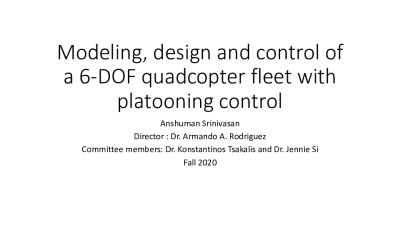Description
Vertical take-off and landing (VTOL) systems have become a crucial component of aeronautical and commercial applications alike. Quadcopter systems are rather convenient to analyze and design controllers for, owing to symmetry in body dynamics. In this work, a quadcopter model at hover equilibrium is derived, using both high and low level control. The low level control system is designed to track reference Euler angles (roll, pitch and yaw) as shown in previous work [1],[2]. The high level control is designed to track reference X, Y, and Z axis states [3].
The objective of this paper is to model, design and simulate platooning (separation) control for a fleet of 6 quadcopter units, each comprising of high and low level control systems, using a leader-follower approach. The primary motivation of this research is to examine the ”accordion effect”, a phenomenon observed in leader-follower systems due to which positioning or spacing errors arise in follower vehicles due to sudden changes in lead vehicle velocity. It is proposed that the accordion effect occurs when lead vehicle information is not directly communicated with the rest of the
system [4][5]
.
In this paper, the effect of leader acceleration feedback is observed for the quadcopter platoon. This is performed by first designing a classical platoon controller for a nominal case, where communication within the system is purely ad-hoc (i.e from one quadcopter to it’s immediate successor in the fleet). Steady state separation/positioning errors for each member of the fleet are observed and documented during simulation. Following this analysis, lead vehicle acceleration is provided to the controller (as a feed forward term), to observe the extent of it’s effect on steady state separation, specifically along tight maneuvers. Thus the key contribution of this work is a controller that stabilizes a platoon of quadcopters in the presence of the accordion effect, when employing a leader-follower approach. The modeling shown in this paper builds on previous research to design a low costquadcopter platform, the Mark 3 copter [1]. Prior to each simulation, model nonlinearities and hardware constants are measured or derived from the Mark 3 model, in an effort to observe the working of the system in the presence of realistic hardware constraints. The system is designed in compliance with Robot Operating System (ROS) and the Micro Air Vehicle Link (MAVLINK) communication protocol.
Included in this item (2)

Permanent Link
Details
Title
- Modeling, Design and Control of a 6 D-O-F Quadcopter Fleet With Platooning Control
Contributors
Agent
- Srinivasan, Anshuman (Author)
- Rodriguez, Armando A. (Thesis advisor)
- Si, Jennie (Committee member)
- Tsakalis, Konstantinos (Committee member)
- Arizona State University (Publisher)
Date Created
The date the item was original created (prior to any relationship with the ASU Digital Repositories.)
2021
Subjects
Collections this item is in
Note
- Partial requirement for: M.S., Arizona State University, 2021
- Field of study: Electrical Engineering

